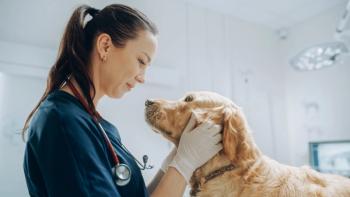
- Firstline May/June 2020
- Volume 16
- Issue 3
Is managing feline hyperthyroidism a team sport?
It sure is, and here’s how veterinary technicians can play their part.
Hyperthyroidism is the most prevalent feline endocrine disease, affecting about 10% of cats age 10 or older.1 It’s caused by a functional tumor of one or both thyroid glands that ignores the body’s regulatory mechanisms and produces excessive amounts of thyroid hormone. Most feline thyroid tumors are benign, but about 2% can be malignant.1
Clinical signs include increased drinking, urination and appetite (polydipsia, polyuria and polyphagia, respectively), along with weight loss. Vomiting, diarrhea and behavioral changes (e.g. increased vocalization) can also occur.
Diagnosis is based on blood testing (baseline total thyroxine and sometimes free thyroxine) and consistent clinical signs. Treatment options include radioiodine, which is considered the treatment of choice,1 and surgical removal of the thyroid gland(s). Both are curative but involve significant up-front costs, so some owners opt for medication (methimazole) or a therapeutic diet, which can manage the problem but isn’t curative.
The good news? Most cats respond favorably to treatment. The not-so-good news? Clinical signs of hyperthyroidism resemble those of kidney disease, diabetes mellitus and even cancer, so early detection isn’t always straightforward. But veterinary technicians can play an important role at every step of the process, from diagnosis to long-term management.
Facilitate earlier diagnosis
Signs of hyperthyroidism are easily misinterpreted or missed completely. A pet owner whose senior cat starts drinking from water faucets may not realize this could indicate polydipsia. And a cat that suddenly eats voraciously may be dismissed as having a “healthy appetite.”
Including thyroid hormone level testing as part of routine wellness screens in senior cats can increase the chances of early detection and prompt treatment. Also, when a middle-aged to senior cat is being examined, an astute veterinary technician can ask the right questions to help determine if the cat is showing subtle disease signs.
Help clients manage at-home therapy
Owners who opt for medication may dread the idea of giving their cat a pill every day for life. Fortunately, veterinary technicians often have tried-and-true methods for medicating cats, and some of these easily translate to home care.
When all else fails, veterinary technicians can recommend other dosing options, such as transdermal formulations, compounded liquids and flavored chews. Technicians should recognize common side effects of methimazole (e.g. vomiting, anorexia, lethargy), so clients can be advised if issues arise. Technicians can also help clients navigate their cat’s transition to a prescription diet.
Focus on client communication
Technicians can spearhead client communications by following up after office visits or medication dosing adjustments, or fielding phone calls when owners have questions.
Promote blood pressure monitoring
Hypertension and hyperthyroidism tend to target the same population of cats—middle aged to seniors.2,3 Blood pressure monitoring in at-risk cats is an excellent way to catch the condition early, before damage to organs, such as the eyes and kidneys, can occur.
Because cats with hyperthyroidism are considered at risk for hypertension, the American Association of Feline Practitioners recommends checking blood pressure during office visits for cats with hyperthyroidism.1
Several portable devices are available for measuring indirect blood pressure in cats. It’s helpful to become familiar with the equipment at your practice, including how to use, maintain and calibrate the device.
Help track patient progress
Recheck exams aren’t just for drawing blood to recheck thyroid levels. These visits are an excellent opportunity to monitor weight gain, assess body condition score, and question the owner about improvements in drinking, urination and other disease signs.
Dr. Todd-Jenkins received her VMD degree from the University of Pennsylvania School of Veterinary Medicine. She is a medical writer and has remained in clinical practice for over 20 years. She is a member of the American Medical Writers Association and One Health Initiative.
References
- Norsworthy GD, Carney HC, Ward CR. 2016 AAFP guidelines for the management of feline hyperthyroidism. J Feline Med Surg 2016;18(9):750.
- Acierno MJ, Brown S, Coleman AE, et al. ACVIM consensus statement: Guidelines for the identification, evaluation, and management of systemic hypertension in dogs and cats. J Vet Intern Med. 2018;32(6):1803-1822.
- Taylor SS, Sparkes AH, Briscoe K, et al. ISFM consensus guidelines on the diagnosis and management of hypertension in cats. J Feline Med Surg 2017;19(3):288-303.
Articles in this issue
over 5 years ago
Thoughts from a small animal surgical nurseover 5 years ago
How to ace a veterinary technician job interviewabout 6 years ago
New managers: 6 tips for a great startabout 6 years ago
Leaky anesthesia machine? How to check the pressure systemsabout 6 years ago
Leaky anesthesia machine? How to check the scavenging systemabout 6 years ago
Leaky anesthesia machine? How to check the breathing systemabout 6 years ago
When felines attack: 5 reasons cats go berserkabout 6 years ago
When a new dog is too much for an older clientover 6 years ago
Cheat sheet: Service dogs, ESAs and petsNewsletter
From exam room tips to practice management insights, get trusted veterinary news delivered straight to your inbox—subscribe to dvm360.




